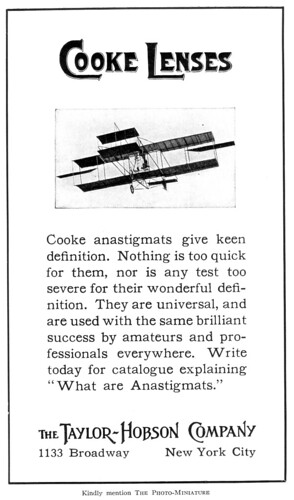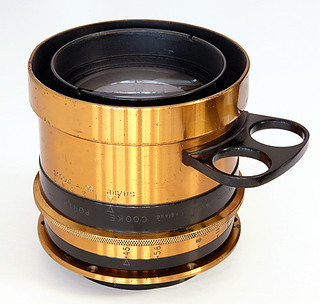Difference between revisions of "Taylor-Hobson"
Hanskerensky (talk | contribs) m (Repaired Link URL) |
m (Corrected Westlicht link/ref; updated TTH company links) |
||
| Line 16: | Line 16: | ||
In 1893 they produced their first Cooke lenses, designed by H. Dennis Taylor (no relation to the company founders) - optics manager of [[Cooke|T. Cooke & Sons]], York. Taylor was attempting to eliminate the aberrations at the outer edge of lenses, and in 1893 patented the Cooke triplet design (British patent no. 1991)<ref>[http://www.cookeoptics.com/cooke.nsf/history/1890s.html Company history] at the [http://www.cookeoptics.com/cooke.nsf/pages/index.html Cooke Optics website]</ref>. Manufacturing rights were offered to '''Taylor, Taylor & Hobson''', as the company was then known. | In 1893 they produced their first Cooke lenses, designed by H. Dennis Taylor (no relation to the company founders) - optics manager of [[Cooke|T. Cooke & Sons]], York. Taylor was attempting to eliminate the aberrations at the outer edge of lenses, and in 1893 patented the Cooke triplet design (British patent no. 1991)<ref>[http://www.cookeoptics.com/cooke.nsf/history/1890s.html Company history] at the [http://www.cookeoptics.com/cooke.nsf/pages/index.html Cooke Optics website]</ref>. Manufacturing rights were offered to '''Taylor, Taylor & Hobson''', as the company was then known. | ||
| − | In 1932, the first Cooke zoom lens was introduced for cine applications. Around this time, Taylor, Taylor and Hobson was part-owned by [[Bell and Howell]].<ref name=EP>[http://www.earlyphotography.co.uk/site/companies3.html#T Company information] at [http://www.earlyphotography.co.uk/index.html Early Photography]; the notes cite Rudolf Kingslake's ''History of the Photographic Lens'' (1989), Academic Press.</ref> By 1939, Taylor-Hobson claim to have produced over 80% of lenses for film studios across the world<ref name=THhistory>[ | + | In 1932, the first Cooke zoom lens was introduced for cine applications. Around this time, Taylor, Taylor and Hobson was part-owned by [[Bell and Howell]].<ref name=EP>[http://www.earlyphotography.co.uk/site/companies3.html#T Company information] at [http://www.earlyphotography.co.uk/index.html Early Photography]; the notes cite Rudolf Kingslake's ''History of the Photographic Lens'' (1989), Academic Press.</ref> By 1939, Taylor-Hobson claim to have produced over 80% of lenses for film studios across the world<ref name=THhistory>[https://www.taylor-hobson.com/aboutus/history Company history] at the [http://www.taylor-hobson.com/ Taylor-Hobson company web site]</ref>. Like much of the British photographic industry, the company became part of Rank at some time in the '40s.<ref name=EP /> |
| − | The company still exists, making lenses and lens measurement equipment, | + | The company still exists, making lenses and lens measurement equipment, as well as measuring devices used in industrial and medical fields <ref>[https://www.taylor-hobson.com/products/overview Products Overview] at the Taylor-Hobson website.</ref>. It is currently part of the US-based Ametek, Inc. The separate lens company, '''[[Cooke|Cooke Optics]]''', also still exists in Leicester. |
William Taylor was also responsible for testing golf balls in a wind tunnel, and developing a dimpled golf ball<ref name=THhistory></ref>. | William Taylor was also responsible for testing golf balls in a wind tunnel, and developing a dimpled golf ball<ref name=THhistory></ref>. | ||
| Line 43: | Line 43: | ||
* Ortal | * Ortal | ||
* Roytal | * Roytal | ||
| − | * Telepanchro<ref>[ | + | * Telepanchro<ref>[https://wlpa.auction2000.se/auk/w.Object?inC=WLPA&inA=20&inO=636 Cooke Telepanchro 16 inch (406 mm) f/4 adapted for Nikon F mount], c1960, sold (for €2160) at the [https://wlpa.auction2000.se/auk/w.ObjectList?inSiteLang=&inC=WLPA&inA=20 20th Westlicht Photographica Auction], on 1 November 2011.</ref> |
*Casket sets | *Casket sets | ||
Revision as of 21:52, 9 July 2020

|
| US advertisement of 1913 scanned by Uwe Kulick (Image rights) |
Taylor-Hobson are lens and precision instrument manufacturers based in Leicester, England.
The company was founded as T.S. and W. Taylor in 1886 by engineer William & optician Thomas Smithies Taylor. In 1887, W.S.H. Hobson joined the company.
In 1893 they produced their first Cooke lenses, designed by H. Dennis Taylor (no relation to the company founders) - optics manager of T. Cooke & Sons, York. Taylor was attempting to eliminate the aberrations at the outer edge of lenses, and in 1893 patented the Cooke triplet design (British patent no. 1991)[1]. Manufacturing rights were offered to Taylor, Taylor & Hobson, as the company was then known.
In 1932, the first Cooke zoom lens was introduced for cine applications. Around this time, Taylor, Taylor and Hobson was part-owned by Bell and Howell.[2] By 1939, Taylor-Hobson claim to have produced over 80% of lenses for film studios across the world[3]. Like much of the British photographic industry, the company became part of Rank at some time in the '40s.[2]
The company still exists, making lenses and lens measurement equipment, as well as measuring devices used in industrial and medical fields [4]. It is currently part of the US-based Ametek, Inc. The separate lens company, Cooke Optics, also still exists in Leicester.
William Taylor was also responsible for testing golf balls in a wind tunnel, and developing a dimpled golf ball[3].
Taylor, Taylor and Hobson Lenses

|
| Cooke Portrait Anastigmat Series IIE, c.1939 10½ inch f/4.5 image by Geoff Harrisson (Image rights) |
- Adotal
- Apotal
- Aviar
- Cooke Amotal
- Cooke Portrait Anastigmat
- Cooke triplet
- Ental
- Ortal
- Roytal
- Telepanchro[5]
- Casket sets
- No. 3 Casket[6]
T-H lenses may be dated from their serial numbers. Taylor, Taylor and Hobson also made Talykron shutters that some of these lenses are mounted in.
Links
- Company history, first page, on the company's homepage

|
| 1913 ad of Taylor-Hobson scanned by Nesster (Image rights) |
| British companies | ||
| Adams & Co. | Agilux | Aldis | APeM | Aptus | Artima | Barnet Ensign | Beard | Beck | Benetfink | Billcliff | Boots | British Ferrotype | Butcher | Chapman | Cooke | Corfield | Coronet | Dallmeyer | Dekko | De Vere | Dixons | Dollond | Elliott | Gandolfi | Gnome | Griffiths | G. Hare | Houghtons | Houghton-Butcher | Hunter | Ilford | Jackson | Johnson | Kentmere | Kershaw-Soho | Kodak Ltd. | Lancaster | Lejeune and Perken | Lizars | London & Paris Optic & Clock Company | Marion | Marlow | Meagher | MPP | Neville | Newman & Guardia | Pearson and Denham | Perken, Son and Company | Perken, Son & Rayment | Photopia | Purma | Reid & Sigrist | Reynolds and Branson | Ross | Ross Ensign | Sanderson | Sands & Hunter | Shackman | Shew | Soho | Standard Cameras Ltd | Taylor-Hobson | Thornton-Pickard | Underwood | United | Watkins | Watson | Wynne's Infallible | Wray |
Notes
- ↑ Company history at the Cooke Optics website
- ↑ 2.0 2.1 Company information at Early Photography; the notes cite Rudolf Kingslake's History of the Photographic Lens (1989), Academic Press.
- ↑ 3.0 3.1 Company history at the Taylor-Hobson company web site
- ↑ Products Overview at the Taylor-Hobson website.
- ↑ Cooke Telepanchro 16 inch (406 mm) f/4 adapted for Nikon F mount, c1960, sold (for €2160) at the 20th Westlicht Photographica Auction, on 1 November 2011.
- ↑ Consisting of the lens barrel with rear element and four interchangeable front elements engraved W.A.R Front, R.R. Front, W.A.R. Back, and R.R. Back. The lens barrel has a built-in iris diaphragm near the front, and is engraved 'EQ.Foc 3in'; 'EQ. Foc 3.34.in' and 'EQ. Foc 5.4 in' with three sets of aperture settings marked 'W.A.R.,' 'R.R.,' 'and 'R.V.' (Seen in an on-line auction Jan 2014).